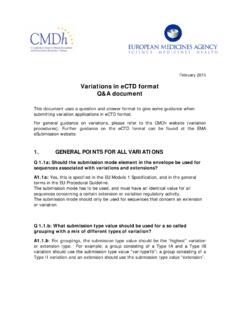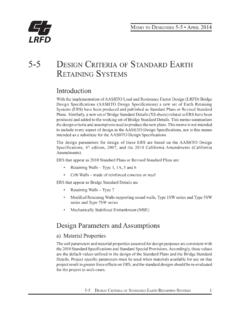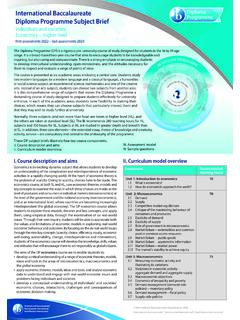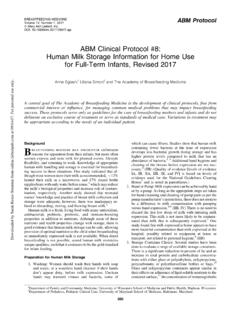Transcription of Question paper (A-level) : Paper 1 - June 2019
1 *JUN197408101* IB/M/Jun19/E7 7408/1 For Examiner s Use Question Mark 1 2 3 4 5 6 7 8 32 TOTAL Monday 20 May 2019 Afternoon Time allowed: 2 hours Materials For this Paper you must have: a pencil and a ruler a scientific calculator a Data and Formulae Booklet. Instructions Use black ink or black ball-point pen. Fill in the boxes at the top of this page. Answer all questions. You must answer the questions in the spaces provided. Do not write outside the box around each page or on blank pages. If you need extra space for your answer(s), use the lined pages at the end of this book. Write the Question number against your answer(s). Do all rough work in this book.
2 Cross through any work you do not want to be marked. Show all your working. Information The marks for questions are shown in brackets. The maximum mark for this Paper is 85. You are expected to use a scientific calculator where appropriate. A Data and Formulae Booklet is provided as a loose insert. Please write clearly in block capitals. Centre number Candidate number Surname Forename(s) Candidate signature A-level PHYSICS Paper 1 2 *02* IB/M/Jun19/7408/1 Do not write outside the box Section A Answer all questions in this section. 0 1 . 1 Two isotopes of iodine are 12553 I and 13153 I. Determine, for these two isotopes, the difference between the constituents of the nuclei. [1 mark] 0 1.
3 2 A 13153 I nuclide undergoes beta ( ) decay to form a xenon nuclide. State the nucleon number of the xenon nuclide. [1 mark] 0 1 . 3 A 12553 I nuclide decays by electron capture to form a tellurium nuclide. State two differences between the constituents of the iodine nucleus and the tellurium nucleus it decays into. [2 marks] 3 *03* Turn over IB/M/Jun19/7408/1 Do not write outside the box 0 1 . 4 Internal conversion is a process in which a nucleus in an excited state can release its excess energy. In internal conversion all of the excess energy is transferred from the nucleus to an orbital electron through the electromagnetic force. This orbital electron is ejected from the atom.
4 The tellurium nucleus formed in Question is in an excited state and can undergo internal conversion. Discuss three differences between internal conversion and beta ( ) decay. [3 marks] 1 2 3 Turn over for the next Question 7 4 *04* IB/M/Jun19/7408/1 Do not write outside the box 0 2 Some cars are fitted with a water sensor designed to switch on windscreen wipers automatically when it rains. Figure 1 shows a simplified diagram of the sensor. Figure 1 A light ray travels from the light-emitting diode (LED) through the first prism and into the windscreen. The ray reflects off the surfaces of the windscreen at A, B and C and then passes through the second prism into the detector.
5 0 2 . 1 Suggest how the design ensures that there is no deviation of the ray as it enters the first prism. [1 mark] 0 2 . 2 Suggest two features of the design that ensure that there is no deviation of the ray as it leaves the first prism and enters the windscreen glass. [2 marks] 1 2 5 *05* Turn over IB/M/Jun19/7408/1 Do not write outside the box 0 2 . 3 The refractive index of the windscreen glass is Explain why the ray follows the path shown inside the windscreen glass in Figure 1. Support your answer with a suitable calculation. [2 marks] Question 2 continues on the next page 6 *06* IB/M/Jun19/7408/1 Do not write outside the box 0 2.
6 4 When it starts to rain, water droplets form on the outside of the windscreen as shown in Figure 2. Figure 2 The refractive index of water is Explain why the presence of water at A causes the intensity of the light at the detector to decrease. Support your answer with a suitable calculation. [2 marks] 7 *07* Turn over IB/M/Jun19/7408/1 Do not write outside the box 0 2 . 5 The refractive index of the windscreen glass can vary by a few per cent across the thickness of the glass. Discuss how this variation may affect the path of the ray through the windscreen glass. [2 marks] 0 2 . 6 A different design has the LED and the detector further apart.
7 The ray undergoes more reflections inside the windscreen glass before reaching the detector. Discuss two ways in which this different design affects the sensitivity of the sensor to the presence of water droplets. [2 marks] 1 2 11 8 *08* IB/M/Jun19/7408/1 Do not write outside the box 0 3 Figure 3 shows an arrangement to investigate diffraction. White light is incident on a single slit. After leaving the slit, the diffracted light passes through a green filter to reach the screen. Figure 3 0 3 . 1 Describe the pattern produced on the screen. [2 marks] 0 3 . 2 The green filter is replaced with a red filter. Describe the change in the pattern produced on the screen.
8 [2 marks] 9 *09* Turn over IB/M/Jun19/7408/1 Do not write outside the box 0 3 . 3 A diffraction grating is placed between the red filter and the screen. The diffraction grating has 500 lines per millimetre. Light is incident normally on the grating. Figure 4 shows the arrangement. Figure 4 The wavelength of the red light is 650 nm. Calculate the angle between a first-order maximum and the central maximum. [2 marks] = degrees Question 3 continues on the next page 10 *10* IB/M/Jun19/7408/1 Do not write outside the box 0 3 . 4 In practice, the filter transmits red light with wavelengths in the range 600 nm to 700 nm. Suggest how this affects the appearance of the maxima.
9 [2 marks] 8 11 *11* Turn over IB/M/Jun19/7408/1 Do not write outside the box 0 4 Figure 5 shows a simplified catapult used to hurl projectiles a long way. Figure 5 The counterweight is a wooden box full of stones attached to one end of the beam. The projectile, usually a large rock, is in a sling hanging vertically from the other end of the beam. The weight of the sling is negligible. The beam is held horizontal by a rope attached to the frame. 0 4 . 1 The catapult is designed so that the weight of the beam and the weight of the empty wooden box have no effect on the tension in the rope. Suggest how the pivot position achieves this. [2 marks] Question 4 continues on the next page 12 *12* IB/M/Jun19/7408/1 Do not write outside the box 0 4.
10 2 The stones in the counterweight have a total mass of 610 kg and the projectile weighs 250 N. Calculate the tension in the rope. [5 marks] tension = N 0 4 . 3 When the rope is cut, the counterweight rotates clockwise. When the beam is vertical it is prevented from rotating further. The projectile is then released horizontally with a velocity of 18 m s 1, as shown in Figure 6. The projectile is released at a height of m above ground level. Figure 6 13 *13* Turn over IB/M/Jun19/7408/1 Do not write outside the box The range of the catapult is the horizontal distance between the point where the projectile is released to the point where it lands. Calculate the range. Ignore air resistance.
















